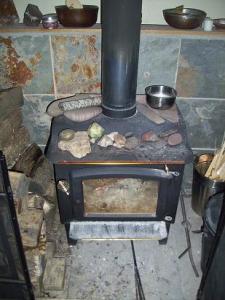Today in St. Paul, MN, it was 37 degrees outside for a high. In Minnesota in February, that is very warm. The sun was out, the birds were singing, the snow was melting, and I thought it would be a good day to check on our compost. For the last two or three months the compost has been frozen through, and has almost filled the entire bin. Like I said earlier, today and the past few days have warmed up significantly and the compost has thawed itself out. We stirred it around and it naturally created some more space in the bin. I didn’t take an internal temperature of the compost, but I am going to guess that it was at least 50 or 60 degrees inside the heart of the compost. In about another month and a half the compost will really start working and reduce in size by at least half and become ready for the garden.
Another winter ritual we have is emptying the ash from the wood burning stove. All of the ash and charcoal gets added right back to the gardens. It also adds organic matter and many trace minerals back into the soil. We get the benefits of slash and burn agriculture without the slashing. All of these practices adds to the soil’s health. Organic matter, added water retention, and trace minerals all add up to a healthier more productive garden.















